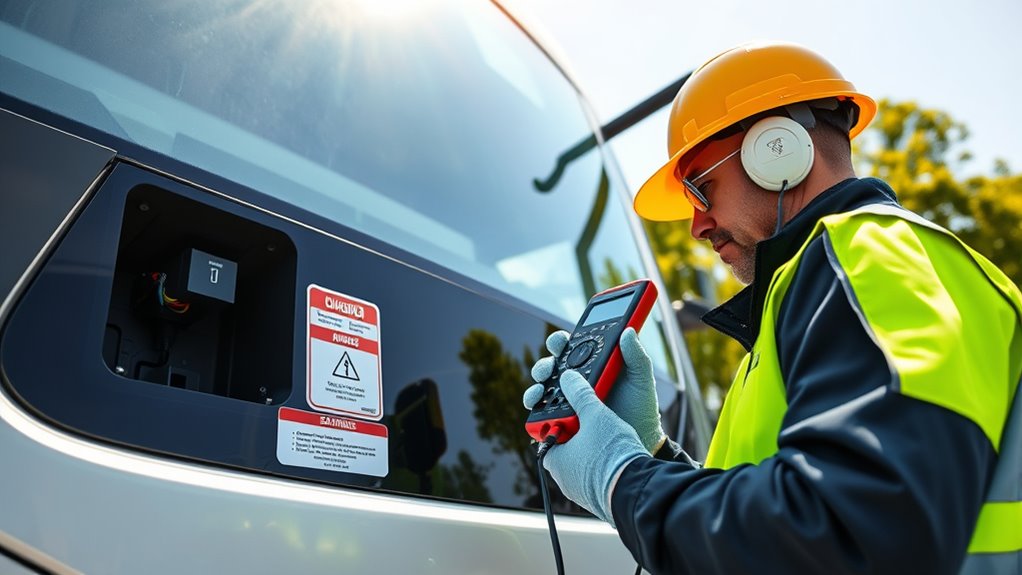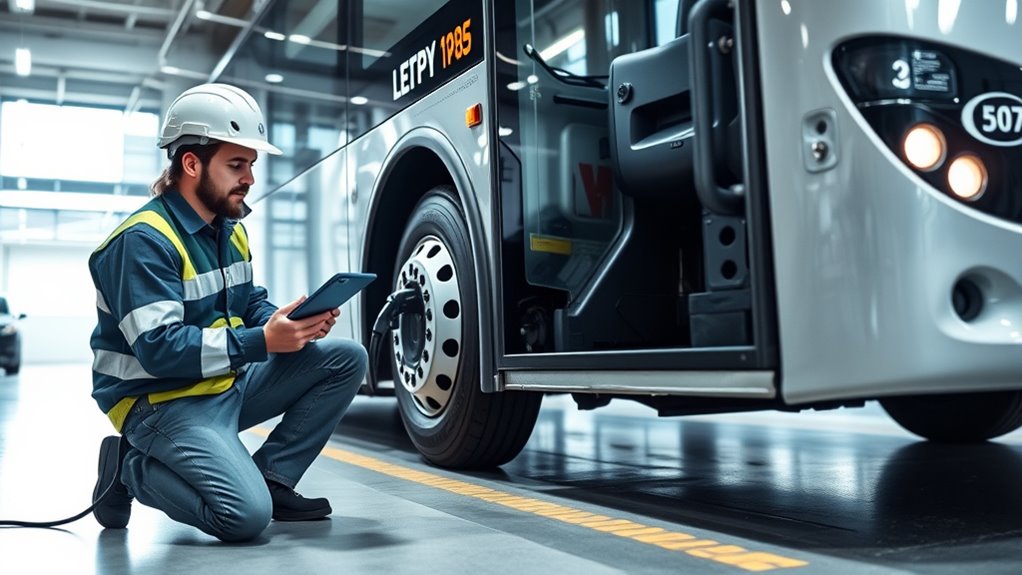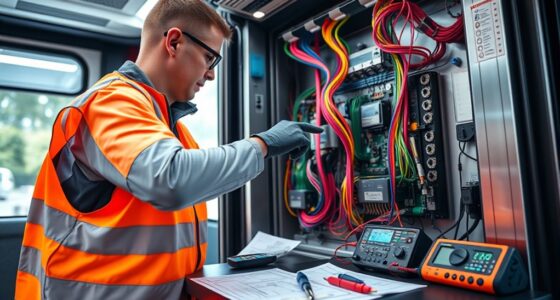Before your electric bus starts its trip, park it on a level surface and guarantee the parking brake is engaged. Check the battery’s physical condition, charge level, and cooling system. Inspect motors, wiring, and electrical connections for damage or corrosion. Test all exterior lights and signals, and verify that emergency equipment is accessible and functional. Confirm that safety signage and devices are in place. For a complete, detailed guide that will help you master every step, continue exploring the process.
Key Takeaways
- Verify the motor and battery compartments for damage, leaks, corrosion, and proper cooling system operation.
- Check battery charge levels and inspect physical condition, including cracks and corrosion.
- Inspect electrical connections for security and signs of corrosion or damage.
- Ensure all exterior lights and signals are functioning correctly.
- Confirm safety equipment like fire extinguishers and emergency markers are accessible and in good condition.

Performing a thorough pre-trip inspection on an electric bus is essential to guarantee safety, compliance, and peak performance before each journey. Start by parking the bus on a level surface, engaging the parking brake, and chocking the wheels if necessary. This ensures the vehicle remains stable during your inspection.
Performing a thorough pre-trip inspection ensures safety, compliance, and optimal performance for each electric bus journey.
As the operator, you should review and complete the inspection checklist carefully, following all local and state regulations for electric buses. Safety equipment checks are a crucial part of this process; verify that fire extinguishers and emergency triangles are present, accessible, and in working order. Record all findings accurately to ensure compliance and provide documentation for future reference.
Next, move to the motor and battery compartments. Check the motor for any visible damage, leaks, or unusual signs that could indicate mechanical issues. Verify the battery’s charge levels and look for any physical damage such as cracks or corrosion. Proper battery health is vital for safe operation and efficiency. Additionally, understanding time zones can be helpful if coordinating service or maintenance across different locations. It’s also important to consult the manufacturer’s specifications for the correct voltage and capacity requirements to ensure the battery operates within safe parameters.
Ensure cooling systems for both the motor and batteries are functioning correctly, maintaining optimal operating temperatures. Inspect all electrical connections to confirm they’re secure and free from corrosion or damage. Don’t forget to check and clean air filters in these compartments to prevent overheating and maintain system efficiency.
Shift your focus to the wheels and tires. Measure tire pressure and examine the tread depth, looking for signs of uneven wear, cuts, or punctures. Properly inflated tires reduce rolling resistance and improve safety. Tighten all wheel nuts to the specified torque, ensuring wheel security, and inspect rims for damage or corrosion that could compromise the wheel’s integrity.
Test the braking system to confirm it responds correctly and stops the bus smoothly. When working under the vehicle, use wheel chocks if necessary to prevent movement, especially if the bus is elevated or on an incline.
Inspect the body and exterior of the bus thoroughly. Check all body panels for dents, cracks, or damage that could affect aerodynamics or safety. Clean and adjust mirrors and cameras for clear visibility, and test all exterior lights, including headlights, turn signals, and brake lights, to ensure they work properly.
Verify that emergency exits are operational and accessible. Confirm that all decals, markings, and safety signage are legible and in compliance with regulations.
Finally, examine the passenger compartment. Look for any damage or wear on seats, and verify the presence and condition of safety devices like seatbelts or restraints. Test the heating and cooling systems to ensure proper ventilation and comfort. Regularly updating inspection procedures can improve the thoroughness and consistency of your checks.
Check that fire extinguishers, first aid kits, and other emergency equipment are present, accessible, and ready for use. Inspect the floor for cleanliness and obstructions, maintaining a safe environment for passengers.
Conclude your inspection by reviewing the electrical and instrument panel, testing gauges, warning systems, and controls to confirm everything functions correctly. Completing these steps meticulously helps ensure your electric bus is safe, compliant, and ready to perform at its best.
Frequently Asked Questions
How Often Should Electric Bus Pre-Trip Inspections Be Performed?
You should perform pre-trip inspections on your electric bus every day before its first use, regardless of whether it’s electric or diesel. This daily check is vital to catch overnight issues like vandalism or component wear.
Even if you inspected it after the previous trip, a fresh pre-trip ensures everything’s functioning properly for safe operation. Following this schedule helps you stay compliant and guarantees passenger safety.
Are There Specific Tools Required for Inspecting Electric Bus Batteries?
You’ll need specific tools to inspect electric bus batteries effectively. Use a multimeter or multifunctional test meter to check electrical parameters.
Insulation resistance testers are used to verify high-voltage insulation integrity.
Battery Management System (BMS) monitors and CAN bus interface tools help diagnose battery performance.
High-voltage probes ensure safe measurement of high-voltage circuits.
Thermal imaging cameras can detect abnormal heat patterns.
Specialized battery testing systems evaluate overall battery health.
What Safety Precautions Are Necessary During an Electric Bus Inspection?
Imagine working on a ticking time bomb—safety is essential. During an electric bus inspection, you should wear personal protective gear, avoid live electrical contact, and keep surfaces clean to prevent slips.
Always verify secure connections and follow electrical safety guidelines. Remember, your vigilance guarantees not just your safety but the safety of everyone relying on that bus, turning potential hazards into manageable risks.
How Do You Identify Potential Electrical System Issues?
You identify potential electrical system issues by carefully inspecting all high-voltage connections for corrosion, looseness, or damage that could cause arcing.
You verify insulation integrity on wiring and cables, ensuring no exposed conductors.
You check grounding and overcurrent protection devices like fuses and breakers for proper function.
Additionally, you review battery enclosure integrity, monitor temperature sensors, and examine charging ports and cords for wear or damage, maintaining safe and reliable operation.
Can Pre-Trip Inspections Be Automated for Electric Buses?
You wonder if pre-trip inspections on electric buses can be turned into a well-oiled machine instead of a manual checklist. Thanks to smart sensors, IoT tech, and diagnostic systems, you’re getting closer to automation.
These tools can spot issues faster than you blink, helping catch problems early. However, don’t forget, human eyes and judgment still play an essential role, ensuring safety isn’t left to machines alone.
Conclusion
By mastering the pre-trip inspection, you’ll keep your electric bus running smoothly like a well-oiled machine. Think of it as your daily ritual to catch small issues before they grow into big problems, ensuring safety and efficiency on every route. Remember, a thorough check is the compass that guides your journey, steering you clear of surprises. Stay vigilant, and your bus will serve you faithfully, turning each trip into a seamless ride through the roads ahead.









